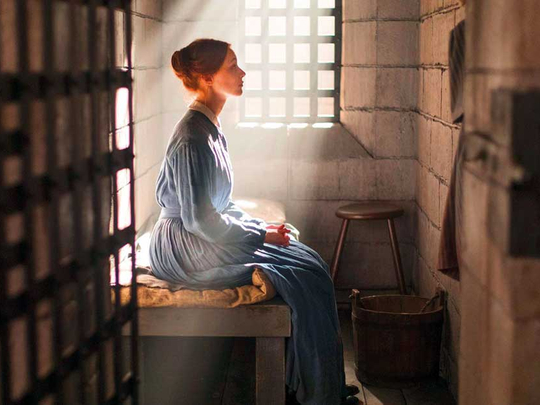
Did you ever suspect that one of 2017’s key fashion references would be “dispossessed 1842 Upper Canadian housemaid”? How about “enslaved walking womb in a dystopian future”? Perhaps not. But in an unsettling year the TV shows that had the biggest impact on our wardrobes centred on two such protagonists.
In case you missed the references, I’m talking about Alias Grace and The Handmaid’s Tale. Both were based on books by Margaret Atwood and both featured women whose lives were ruled and ruined by the patriarchy. Both characters’ clothes were symbols of their repression: their dresses covered them up; their bonnets restricted their view.
These dramas reflected more than the news agenda with eerie prescience. Not only was the Handmaid’s Tale cloak the definitive Halloween costume of 2017 (and a garment worn in protests), but it was echoed — consciously or otherwise — in a number of looks on the high street and from designers.
Was it a coincidence that red was the undisputed colour of the autumn-winter season? That “modest dressing” was the macro-trend of the year? At Uniqlo, a long red dress that could not have felt more Offred was one of the season’s sellout items.
In September, Preen showed a collection that was officially inspired by The Scarlet Letter but felt straight from the Republic of Gilead, comprising bright red-and-white dresses teamed with little bonnets.
It’s all a long way from Sex and the City, the most archetypal of TV fashion references. Yes, Carrie Bradshaw had her issues (in one episode, her crisis point was not being mugged, per se, but being forced to hand over her Manolo Blahniks), but her look was exuberant and jolly, even if it did spark a million credit card bills. Similarly, from Gossip Girl to Friends to My So Called Life to Mad Men’s va-va-voom dresses, via The Cosby Show’s Denise Huxtable, notable TV fashion icons have usually taken a colourful, pre-watershed approach to getting dressed.
Even in Twin Peaks, the clothes — Audrey’s ruffle-necked blouses, kilts and velvet dresses — were perky, even when the storylines were not.
The Atwood aesthetic is different. The Handmaid’s Tale is melancholy in its beauty. It has repeatedly been compared to a Vermeer painting, each scene a Milkmaid or a Woman in Blue Reading a Letter come to life. Its costume designer, Ane Crabtree, speaks as esoterically as any fashion week designer about her inspirations: the deep red of the handmaids and the teal of the commanders’ wives were based on a photograph of a maple leaf against a blue sky; the moss green worn by the other housemaids was inspired by “an old mop” .
Alias Grace is less painterly, but equally easy on the eye. The clothes are painstakingly thought-out and just as accidentally fashionable — all white-collared dresses in faded shades of blue, muted checks and no-nonsense centre partings that could easily be seen on models on the Celine catwalks. (Incidentally, Atwood has cameos in both series and looks pretty high fashion herself: her disapproving churchgoer in Alias Grace is very Alexander McQueen; her The Handmaid’s Tale warden is chillingly Jil Sander.)
These outfits were not created to be aspirational. Alias Grace’s costume designer, Simonetta Mariano, says that the fabrics were muted — “stained and faded and bleached by the sun” — because Grace lived an unspeakably hard life.
Her modesty is vital, partly because “if you were a maid, you couldn’t be more attractive than your bosses”, she says. The onus was on maids to make themselves invisible; to keep their tempting bodies hidden from men’s view. “It reminds me of what is happening again now,” says Mariano. “You don’t want to think that you have triggered anything; the only way the maids had to protect themselves was not to get in any trouble.”
Thankfully, the modern urban adoption of a similar look — covered-up, rugged, rural and old-timey, almost to the point of conjuring up the couple with the pitchfork in Grant Wood’s American Gothic — usually means something quite different. It is often chosen by the sort of consumer who cares about the image they project, but does not wish to show off their bodies, a choice that is its own form of empowerment. Someone who dresses to accentuate their discerning taste levels, not their hip/waist ratio.
As for the bonnets? Let’s assume their use on the Preen catwalks was for dramatic effect and not the start of a trend. Because when bonnets come back, I suspect, we really will be stuffed.












